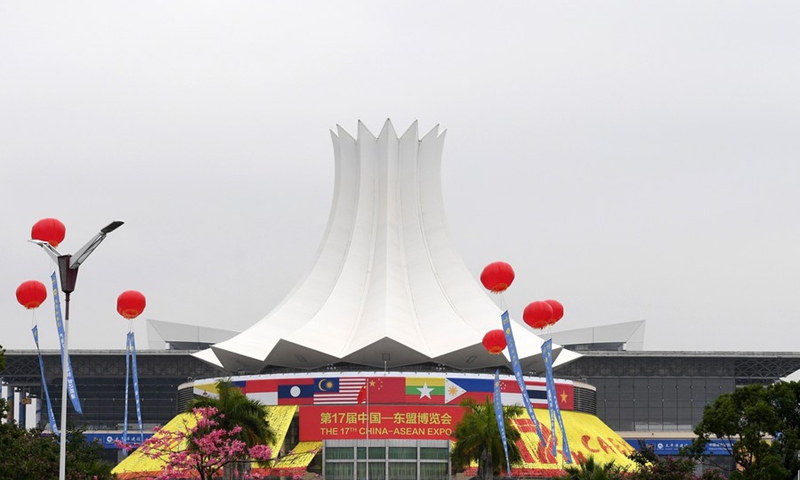
Photo taken on Nov. 27, 2020 shows Nanning International Convention and Exhibition Center in Nanning, south China's Guangxi Zhuang Autonomous Region. (Photo: Xinhua)
China and the Association of Southeast Asian Nations (ASEAN) are deepening cooperation to build a highly open and integrated China-ASEAN market to further stabilize the regional industrial and supply chains.
This is the sixth year Malaysian entrepreneur Wong Kok Loong has participated in the annual China-ASEAN Expo since 2015. Due to the COVID-19 pandemic, Wong is doing business through the expo's online platform this year.
Due to COVID-19, this year more than 1,500 enterprises from home and abroad have participated virtually in the four-day event which opened on Nov. 27 in Nanning, capital of south China's Guangxi Zhuang Autonomous Region.
"I received more than 10 orders from Chinese entrepreneurs on the first day," said Wong, who owns a durian product processing factory in Malaysia. To tap the huge Chinese market, he opened online stores on the country's e-commerce platforms like Tmall and JD.com.
"Since March, we have exported 5,000 boxes of durian products to the Chinese market. The factory's production line is very busy," said Wong. "To meet the demand of Chinese consumers, my company has developed 85 kinds of durian products," he added.
Wong's booming business mirrors the widely open and integrated China-ASEAN market since the implementation of the China-ASEAN Free Trade Agreement (CAFTA) in 2010. In the last decade, the trade in goods and services between China and ASEAN countries has grown rapidly through the deep integration of industrial and value chains.
Under the CAFTA framework, tariffs on 7,000 products have been scrapped. The trade volume between China and ASEAN countries exceeded 600 billion U.S. dollars in 2019 while it was only 54.8 billion U.S. dollars in 2002, according to data by the Ministry of Commerce.
ASEAN has become China's largest trading partner. In the first 10 months of this year, bilateral trade between China and ASEAN increased 7 percent year on year to 3.79 trillion yuan (about 571.64 billion U.S. dollars), accounting for 14.6 percent of the country's foreign trade, according to China's General Administration of Customs.
For 10 years now, the China-ASEAN Free Trade Agreement has enabled the two sides to chart a resilient and mutually beneficial relationship, said ASEAN Secretary-General Lim Jock Hoi at a forum of the expo held via video link on Saturday.
As ASEAN and China confront the challenges brought about by COVID-19, it becomes even more imperative for both sides to strengthen collaboration and cooperation in trade and investment, to ensure unimpeded flow of goods, and to see that supply chains remain resilient, he added.
"The directions we have been taking for ASEAN-China cooperation are in line with our aspiration to further deepen our regional economic integration," Haji Mohd Amin Liew Abdullah, Brunei's minister at the Prime Minister's Office and second minister of finance and economy, said at the forum.
"The upgrading protocol of the CAFTA is timely. I believe its realization will contribute to unlocking new business opportunities and further enhancing our two-way trade and investment, as well as contribute to the post-pandemic economic recovery of the region," he added.
"Strengthening supply chain connectivity is clearly very important. Therefore, I hope that ASEAN and China will continue to work together to maintain regional and global economic stability, and bring tangible and meaningful benefits to our people and businesses," Vietnamese Minister of Industry and Trade Tran Tuan Anh said at the forum.
Chan Chun Sing, Minister of Trade and Industry of Singapore, said as the CAFTA is a cornerstone of the economic growth of both ASEAN and China, it is imperative for both parties to remain engaged in each other's markets.
"We should also actively shape the future blueprint of CAFTA through exploring possible new areas for win-win cooperation such as e-commerce and the reduction of non-tariff barriers, and strengthening supply chains, among others," he noted.
This year's expo also highlights the Regional Comprehensive Economic Partnership (RCEP), which was signed earlier this month by 15 Asia-Pacific countries, including ASEAN's 10 member states and China. It is a massive move for regional economic integration, multilateralism and free trade.
Xu Ningning, executive president of the China-ASEAN Business Council, said that opening up the markets of the 15 countries to one another will bring about new changes and closer regional cooperation.
